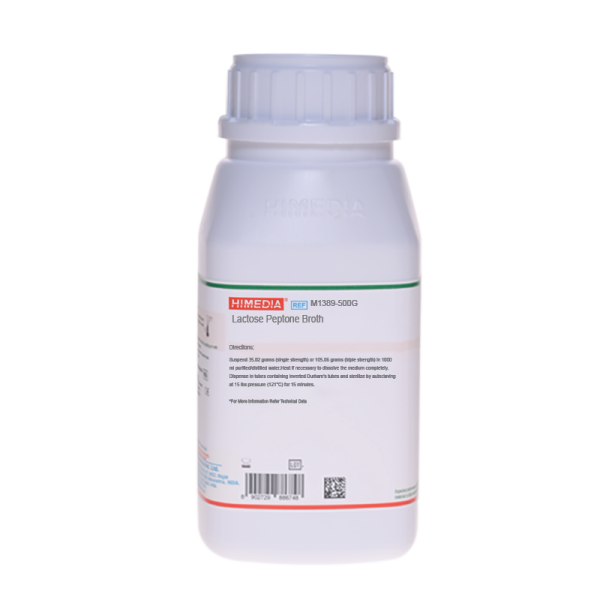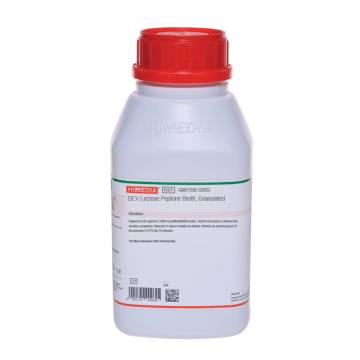 Your enquiry has been submitted
Your enquiry has been submitted
Lactose Peptone Broth
Intended Use
Recommended for detection of coliform organisms in water.
Composition
| Ingredients | Gms/Litre |
|---|---|
| Tryptone | 17.000 |
| Soya peptone | 3.000 |
| Lactose | 10.000 |
| Sodium chloride | 5.000 |
| Bromocresol purple | 0.020 |
| Final pH (at 25°C) | 7.4±0.2 |
**Formula adjusted, standardized to suit performance parameters
Directions
Suspend 35.02 grams (single strength) or 105.06 grams (triple strength) in 1000 ml purified/distilled water. Heat if necessary to dissolve the medium completely. Dispense in tubes containing inverted Durham's tubes and sterilize by autoclaving at 15 lbs pressure (121°C) for 15 minutes.
Principle And Interpretation
Coliform bacteria are commonly used as bacterial indicator of sanitary quality of foods and water. Where it is claimed that drinking water has been processed for safety, the finding of such organism demonstrates a failure of the process. It is a valuable bacterial indicator for determining the extent of faecal contamination of recreational surface waters or drinking water (1). Coliforms are defined as rod-shaped gram-negative organisms, which ferment lactose with the production of acid and gas when incubated at 35°C. Lactose Peptone Broth was originally described in German Standard Methods and German Drinking Water Regulations (2) as a non-selective enrichment and detection medium for Escherichia coli and other coliforms in water specimens. German standards suggest the use of MPN technique with 0.1, 1.0 and 10 ml of sample and an incubation at 36 ± 1°C for 44 ± 4 hours. Depending upon the sample volume the medium can be either used as single strength or triple strength. Tubes that change to yellow and eventual gas production in Durhams tubes are considered positive. Tryptone and Soya peptone provide all the essential nitrogenous growth nutrients. Lactose is the fermentable sugar. Lactose fermentation and gas production form the basis for the presumptive coliform identification. Sodium chloride maintains osmotic equilibrium. Bromocresol purple is the pH indicator of the medium, which turns yellow as a result of acid production from the fermentation of lactose.
Type of specimen
Water samples
Specimen Collection and Handling
For water samples, follow appropriate techniques for sample collection, processing as per guidelines and local standards (3). After use, contaminated materials must be sterilized by autoclaving before discarding.
Warning and Precaution
Read the label before opening the container. Wear protective gloves/protective clothing/eye protection/face protection. Follow good microbiological lab practices while handling specimens and culture. Standard precautions as per established guidelines should be followed while handling specimens. Safety guidelines may be referred in individual safety data sheets.
Limitations
- Individual organisms differ in their growth requirement and may show variable growth patterns on the medium.
- Each lot of the medium has been tested for the organisms specified on the COA. It is recommended to users to validate the medium for any specific microorganism other than mentioned in the COA based on the user's unique requirement.
- Further analysis for biochemical and serological testing is required for complete identification.
Performance and Evaluation
Performance of the medium is expected when used as per the direction on the label within the expiry period when stored at recommended temperature.
Quality Control
Appearance: Cream to greenish yellow homogeneous free flowing powder
Colour and Clarity of prepared medium: Purple coloured, clear solution without any precipitate
Reaction: Reaction of 3.5% w/v aqueous solution at 25°C. pH : 7.4±0.2
pH: 7.20-7.60
Cultural Response
Cultural characteristics observed after an incubation at 35-37°C for 24-48 hours.
| Organism | Inoculum (CFU) | Growth | Acid production | Gas Production |
|---|---|---|---|---|
| Escherichia coli ATCC 25922 (00013*) | 50-100 | luxuriant | positive reaction, yellow colour | positive reaction |
| Salmonella Typhimurium ATCC 14028 (00031*) | 50-100 | luxuriant | negative reaction | negative reaction |
Key: (*) corresponding WDCM numbers
Storage and Shelf Life
Store between 10-30°C in a tightly closed container and the prepared medium at 15-25°C. Use before expiry date on the label. On opening, product should be properly stored dry, after tightly capping the bottle inorder to prevent lump formation due to the hygroscopic nature of the product. Improper storage of the product may lead to lump formation. Store in dry ventilated area protected from extremes of temperature and sources of ignition. Seal the container tightly after use. Product performance is best if used within stated expiry period.
Disposal
User must ensure safe disposal by autoclaving and/or incineration of used or unusable preparations of this product. Follow established laboratory procedures in disposing of infectious materials and material that comes into contact with sample must be decontaminated and disposed of in accordance with current laboratory techniques (4,5).
Reference
- Corry J. E. L., Curtis G. D. W. and Baird R. M., 1995, Culture Media for Food Microbiology. Vol. 34, Progress in Industrial Microbiology, Elsevier, Amsterdam.
- DIN Deutsches Institute für Normung, 1991, e.V.: Deutsche Einheitsverfahren zur Wasser-, Abwasser-und Schlammunter suchung: Mikrobiologische Verfahren (Gruppe K), Nachwels von Escherichia coli und coliformen Keimen (K6). Reference Method DIN 38411.
- Baird R.B., Eaton A.D., and Rice E.W., (Eds.), 2015, Standard Methods for the Examination of Water and Wastewater, 23rd ed., APHA, Washington, D.C.
- Isenberg, H.D. Clinical Microbiology Procedures Handbook 2nd Edition.
- Jorgensen, J.H., Pfaller, M.A., Carroll, K.C., Funke, G., Landry, M.L., Richter, S.S and Warnock., D.W. (2015) Manual of Clinical Microbiology, 11th Edition. Vol. 1.
| Product Name | Lactose Peptone Broth |
|---|---|
| SKU | M1389 |
| Product Type | Regular |
| Physical Form | Powder |
| Origin | Animal |
| Packaging type | HDPE |
| References | 1. Corry J. E. L., Curtis G. D. W. and Baird R. M., 1995, Culture Media for Food Microbiology. Vol. 34, Progress in IndustrialMicrobiology, Elsevier, Amsterdam |
| Customized Product Available | No |






